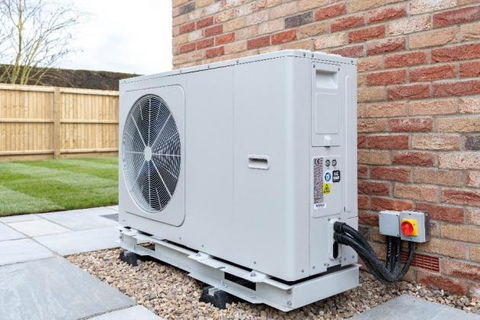Heat pump (HP) installations, despite some of the market challenges – see MCS report July 2023 – represent major opportunities for UK installers.

Inverter based control is central to the operation* of HP systems and fundamental to the UK, as most domestic properties are connected to single phase supplies. Inverter control reduces the starting current peaks associated with HP compressors. In installations requiring RCD protection, the characteristics of the inbuilt inverter equipment determine the Type of RCD to be installed up-stream.
*Improved HP designs with reduced starting current peaks and increased efficiency.
Equipment design characteristics
For single phase installations, the use of type F or B RCDs is governed by the level of smooth dc residual current produced under certain fault conditions. This fault current is related to the value of the “dc link voltage” (Fig 1) i.e. it is a function of the internal equipment design – see below. Three phase inverter-based equipment without built-in galvanic isolation, requires the use of type B RCDs - see BS 7671 531.3.3.(iv). For additional information refer to Doepke website Techpub-17 .
DC link voltage dictates the Type of RCD
Figure 1 gives a generic example of a single phase combined compressor and fan unit. The dc voltage output from the rectifier will be a minimum of 1.41 x ac rms voltage. Designs may include a step-up voltage section to increase the dc voltage before it is fed into PWM control section. Capacitors connected across the dc bus provide smoothing, for the non-conducting period associated with the AC supply. For example, a high resistance fault between the dc link section and the HP’s earthed casing (IF = VL/RF), results in a low value smooth dc residual current flowing in the PE conductor. RCDs connected in series with the HP, will be subject to a function (< IF) of this smooth DC residual current.
If the HP manufacturer cannot provide advice on the Type of RCD that should be used with their equipment, the only safe option is Type B – see BS7671 531.3.3:
-
Smooth dc fault current <10 mA: Type F RCD can be used – see (iii) Note 2.
-
Smooth dc fault current >10 mA: Type B RCD must be used - see (iv) Note 3.
-
Note you cannot install Type F or B RCDs down stream of Type A RCDs.
HP and RCD sensitivity
To reduce the risk of unwanted tripping, BS7671 531.3.2 (ii) recommends that the AC operational leakage (PE) current is ≤ 30% of the RCD sensitivity (I∆n).
The reasoning behind this, the RCD may trip at > 0.5 I∆n. PE current can increase because of supply quality (harmonics) e.g. filters, inverters, LED lighting and the amount of local PV generation. When adding new equipment to an existing installation containing an RCD incomer, consider the addition of PE currents i.e. existing equipment + new equipment. Even small HPs + backup heater system represent a significant increase in load (running current) for existing single phase installations – see recommended design / demand calculations detailed in the IET Guide to Implementing Electrified Heat in Domestic Properties.
Type F and Type B RCDs are designed to respond to the sum of the leakage / residual currents, generated at various frequencies by inverter-controlled equipment – see Techpub-17. Before purchasing equipment, check the installation manuals to verify the minimum RCD sensitivity requirements. If it is not in the manual, ask the supplier to provide this information before you purchase.
BS7671 543.7.1 places limits on the PE current, based on the method of connection:
-
< 10 mA: Plug connection & 30 mA RCD or permanently wired to the supply.
-
> 10 mA: Additional requirements apply to the PE conductor – see 543.7.1.202 & 3.
Conclusion
Check the HP manufacturer’s installation requirements. Ask the manufacturer for advice on the Type of RCD to be used with their equipment. If they cannot provide this, the only safe option is Type B – ref 531.3.3. To reduce the risk of unwanted tripping, the AC leakage (PE conductor current) must be compatible with the installation design and associated RCD sensitivity – ref 531.3.2. Type F or B RCDs must not be installed downstream of Type A RCDs (in series). Assumptions can be costly, check before purchasing equipment.
